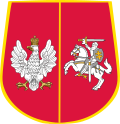Litwa Środkowa
| Litwa Środkowa | |||||
| Central Lithuania | |||||
| 1920-1922 | |||||
|
|||||
| Official language | Polish | ||||
| Capital | Vilna | ||||
| Head of state , also head of government | Lucjan Żeligowski | ||||
| currency | mark | ||||
| founding | October 12, 1920 | ||||
| resolution | 1922 to Poland | ||||
| Map of Litwa Środkowa (green) and Lithuania (gray) | |||||
Litwa Środkowa ('Central Lithuania ') was the name of a state proclaimed in 1920 in the predominantly Polish- speaking eastern part of the Republic of Lithuania with the capital Vilnius , which joined Poland in 1922 . Because Poland, Lithuania and the Soviet Union laid claim to the state territory, its affiliation was referred to as the Vilnius question .
prehistory
Poland and Lithuania were united by the Lublin Union of August 12, 1569. After Prussia, Austria and the Russian Empire had divided Poland among themselves , the "Wilna region" was annexed by the Russian Tsarist Empire. From 1918 it had belonged to the newly established Republic of Lithuania. After the withdrawal of the German troops, the struggle of Lithuania, Poland and Soviet Russia began for dominance in this area on the upper Neris , with the cities of Vilnius , Asmjany and Švenčionys . Poland claimed the Wilna area for ethnographic and cultural reasons, Lithuania for historical reasons.
Establishment of the state and affiliations
After the beginning of the Polish-Soviet War , Polish troops under the command of General Lucjan Żeligowski occupied the area previously occupied by the Red Army . On October 12, 1920, Żeligowski, together with a provisional government, proclaimed the state of "Central Lithuania" on the Wilna area, which was expanded to include territories bordering to the east. The majority of the population in Central Lithuania were Poles with 70.6%, followed by 12.8% Lithuanians and 6% Belarusians. In the city of Vilnius, according to the German census of 1916, only 2.6% spoke Lithuanian. After Poland's efforts to re-establish its national borders from 1772 or corresponding confederative alliances with Lithuania had failed, the parliament of Central Lithuania voted on February 20, 1922 for annexation to Poland.
Lithuania did not recognize this development, declared Kaunas to be its provisional capital and only gave up its claim to Vilnius in 1938 under the ultimate Polish claim.
In 1939, in the secret additional protocol to the Hitler-Stalin Pact , Poland was divided up along a demarcation line between the German Reich and the Soviet Union . The western part of the former central Lithuania with the city of Vilnius was returned to Lithuania in October 1939 . In June 1940 the Red Army invaded Lithuania. After the installation of a communist government, Lithuania joined the Soviet Union on August 3, 1940 as the Lithuanian Soviet Socialist Republic . The Soviet Union saw the Wilna area not as a Polish but as an occupied Lithuanian national territory and also annexed it.
See also
Web links
Individual evidence
- ↑ Alicja Fiedler: Multilingualism in Lithuania using the example of the Polish minority . In: Stefan Daute, Adrian Fiedler (eds.): Slavic national minorities in the Baltic Sea region. Universitätsverlag Potsdam, 2008, ISBN 978-3-940793-63-8 , pp. 45–75, here pp. 50–51 ( online )
- ^ Wanda Krystyna Roman: The Soviet occupation of the Polish eastern territories 1939–1941 . In: Bernhard Chiari (ed.), Jerzy Kochanowski: The Polish Home Army: History and Myth of the Armia Krajowa since the Second World War (= contributions to military history, volume 57). Munich 2003, p. 96




